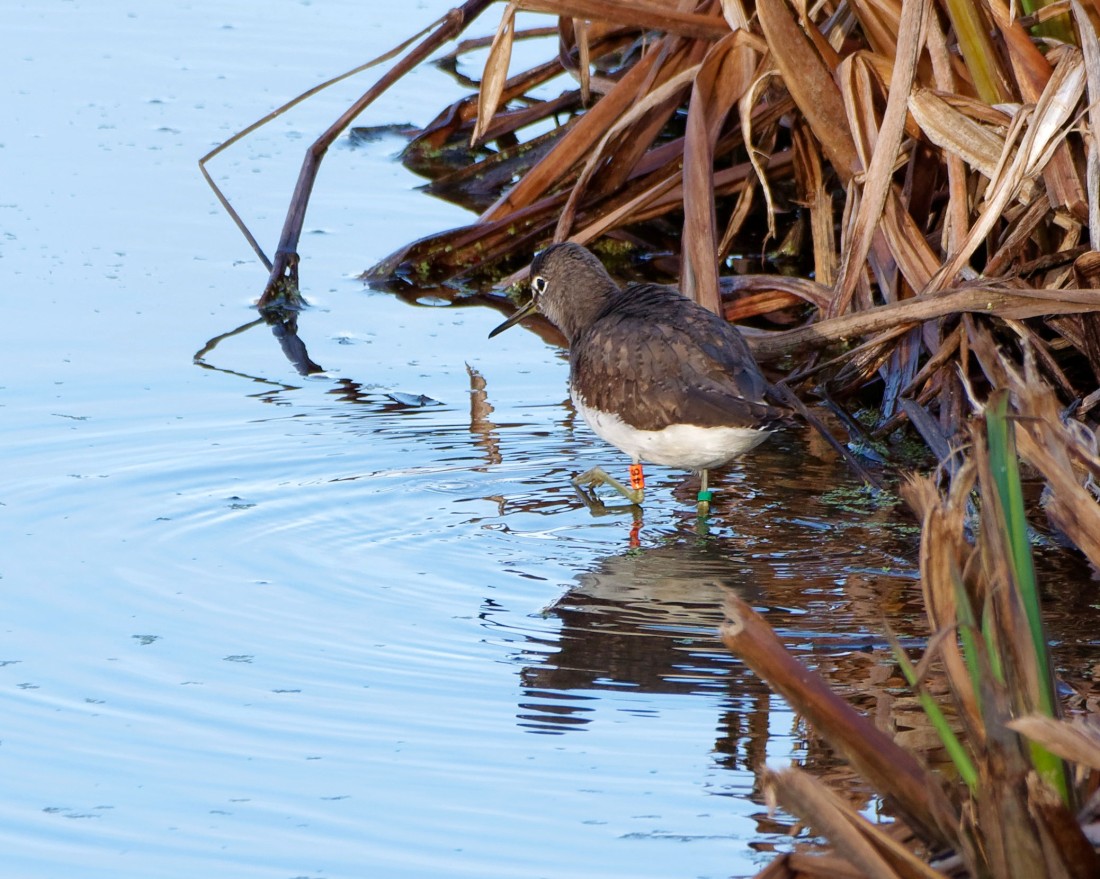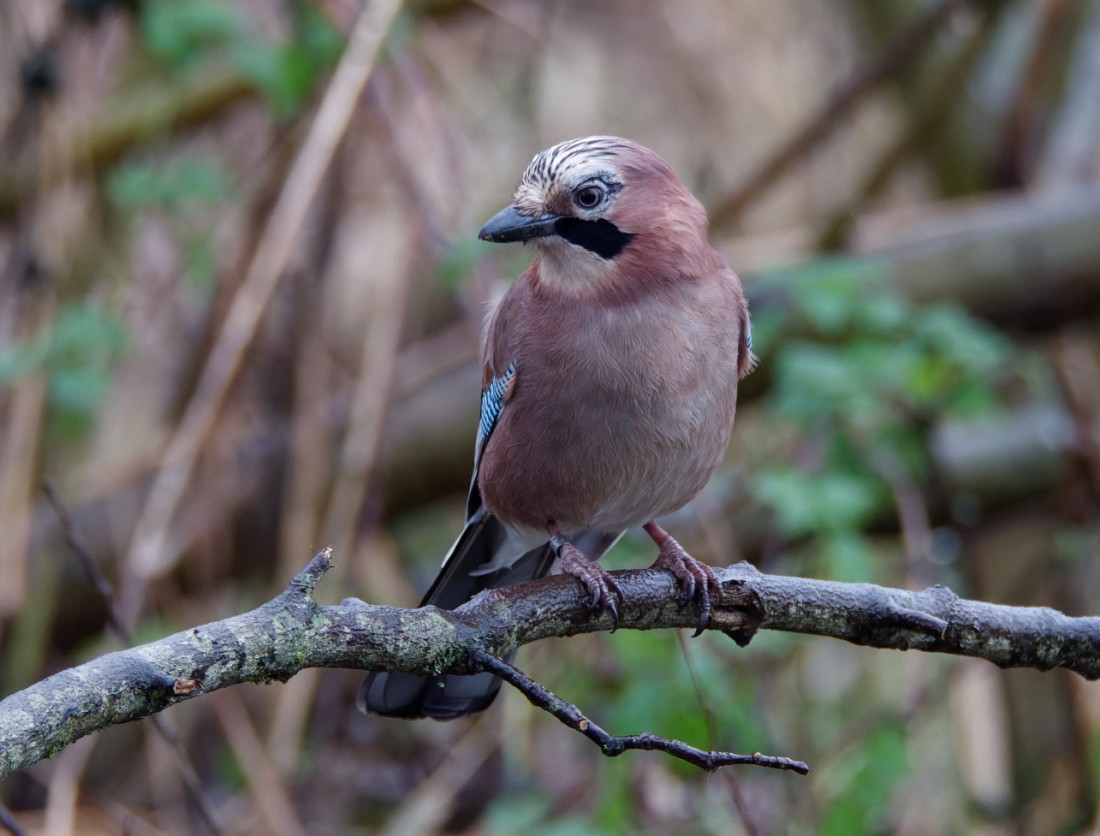Woolston Eyes Monthly Sightings
2021-12-30
For our final session of the year at Woolston Eyes the day dawned with a spring-like warmth, some atmospheric skies and plenty of birds, including 7 Bramblings, 5 Siskins and 9 Pochard.. Reflecting on the year, though, brings mixed emotions. The publication of the 2021 review of the Birds of Conservation Concern was as devastating as expected. Since the first review was published in 1996, the number of our UK species in serious decline has almost doubled to 70, with many more on the verge of joining them. On the balance side, we have pushed on with our plans for habitat creation, with the No.4 bed wetland close to completion and the creation of a network of small pools on No.1 bed continuing apace. Its fair to say, I think, that the habitat on the Reserve has never been in better order. The 150 species recorded during 2021 is a pleasing total, with highlights of: Glossy Ibis, White Stork, Tundra Bean Geese, Dark-bellied Brent Goose, Woodlark, Common Scoter, Garganey, Goshawk, Ring Ouzel, Hawfinch, Avocet, Kittiwakes, Yellow-legged Gull, Common Crossbill, Osprey, Red Kite, Bittern, Great White Egret and Siberian Chiffchaffs. In addition, a first breeding pair of Marsh Harrier, a return to breeding for Teal and a good breeding season for two of our key species, Black-necked Grebe and Pochard, made for an excellent year, despite Covid’s best efforts to put a damper on proceedings. Have a Happy New year everyone and roll on 2022. Photo from the Morgan Hide David Bowman (with Daniel Owen)
Submitted by: David Bowman
2021-12-28
It didn’t look too promising this morning, as a gloomy dawn brought with it some heavy rain. As ever, though, there were plenty of birds to be found when the rain eventually passed. A few Bramblings were among the commoner finches on No.3 bed before we we walked on to No.4 bed to check on progress with the new wetland. Its pleasing to report that the western cell should be finished within the next fortnight. We can then close the sluice and start raising the water level ahead of the 2022 breeding season. Even now, it is holding about 650 water-birds, including 1 Little Grebe, 160 Lapwings, 67 Mallard, 200 Teal, 11 Shoveler, 36 Gadwall, 37 Coot,140 Black-headed Gulls, 2 Great Black-backed Gulls, 2 Lesser Black-backed Gulls, 3 Common Gulls and 6 Herring Gulls. Further variety was added around the margins and on the islands, with 1 Kingfisher, 2 Ravens, 1 Chiffchaff, 7 Goldcrests, 2 Siskins, 1 Snipe, 2 Cetti’s Warblers, 2 Pied Wagtails, 2 Grey Wagtails and 5 Reed Buntings. Photo of a Goldfinch Cheers David Bowman (with Daniel Owen)
Submitted by: David Bowman
2021-12-23
We’ve recently started ground-feeding at the various feeding stations and out on the North Meadow and I counted at least 20 Bramblings, 130 Goldfinches, 120 Chaffinches, 80 Greenfinches plus smaller numbers of Siskins, Linnets, Lesser Redpolls and Reed Buntings as I wandered round. From the Morgan Hide, the long-staying, wing-tagged juvenile male Marsh Harrier came out of its roost at dawn and drifted off to be replaced by an immature female, which flushed about 1,000 Teal from cover in the reed bed. Also noteworthy was the arrival of a colour-ringed Green Sandpiper in front of the hide, presumably the same one which has been around since it was ringed on the bed in late September, though I was unable to read the number to confirm it. Photo of a Jay Cheers David Bowman
Submitted by: David Bowman
2021-12-22
Yesterday was still and overcast but there were still plenty of birds to be found around No.3 bed. Early on, plenty of gulls were moving inland with totals of 6 Great Black-backs, 21 Herrings and 800 Black-headed. Among the hundreds of finches around the feeding stations and seed crop were at least 11 Bramblings, 6 Siskins and a couple of Lesser Redpolls, while the roving tit flocks carried with them a couple of Chiffchaffs and at least 7 Goldcrests. Four skeins of Pink-footed Geese passed over, heading towards the Lancashire coast and as ever at this time of year, Scandinavian thrushes were in short supply. with just 10 Redwings present. You’d have been forgiven for thinking there weren’t many wildfowl around, other than a couple of Wigeon, 4 Pochard, 2 Shelducks,30 Shovelers and a few Gadwall and Mallards, until a Marsh Harrier flushed 1,000 Teal from cover! Photo of a Long-tailed Tit Cheers David Bowman (with Daniel Owen)
Submitted by: David Bowman
2021-12-19
WeBS Count 18/12/2021 Little Grebe 10, Great Crested Grebe 6, Mute Swan 25, Cormorant 17, Grey Heron 5, Greylag Goose 38, Canada Goose 59, Shelduck 4, Gadwall 135, Teal 923, Mallard 163, Pintail 3, Shoveler 58, Tufted Duck 358, Goldeneye 2, Water Rail 2, Moorhen 39, Coot 91, Jack Snipe 4, Woodcock 1, Black-headed Gull 110, Common Gull 3, Herring Gull 12, Kingfisher 1. Two female Marsh Harriers also seen the wing-tagged bird on No.4 and another on No.3 bed
Submitted by: Brian Martin
2021-12-12
This link is to a very brief video clip showing two wintering Green Sandpipers in front of the Sybil Hogg Hide, one of which was colour-ringed on No.3 bed, by Kieron Foster and his team on 25th September. To watch David’s video CLICK HERE… or cut and paste the following link into your browser.
https://youtu.be/GO_rZ4sMQB8
Cheers David
Submitted by: David Bowman
2021-12-11
Once a month, from September to December, we spend the morning perched on a viewpoint at the eastern end of the Reserve, counting all the birds which pass over. Although most of the southerly passage has finished by December, we sometimes turn up some really interesting sightings and today was no exception. Soon after dawn flocks of finches started moving south, mainly Chaffinches but the surprise came when a flock of 250 passed overhead and proved to contain at least a 100 Bramblings - an unprecedented movement for us. By the end of the morning 134 Bramblings and 425 Chaffinches had been counted (the former a record count). Pink-footed Geese and Woodpigeons were also on the move, with a final totals of 2,160 and 4,130 respectively. Interestingly, more than 1,000 of the geese dropped in to feed on arable fields to the north-east of our position. Thrush numbers, as expected, were low, with just 85 Fieldfares and 15 Redwings, while a single Golden Plover was with the hundreds of Lapwings. A final notable count came when we walked the weedy area around our chairs and flushed 15 Jack Snipe from an area no more than 30 yards square. With heavy rain in the offing by late morning, we retired to the Hogg Hide on No.3 bed, where a Green Sandpiper paid a brief visit to cap a brilliant morning. Photo of a Robin Cheers David (with Dave Steel, Dan Owen and Helen Wynn)
Submitted by: David Bowman
2021-12-09
The previous two visits were characterised by gale force winds and horizontal icy rain, though there were still plenty of birds to be found, including Jack Snipe, Pintail, Marsh Harrier, Bramblings, Pink-footed Geese and Willow Tits. This morning, however, brought one of those clear cold, early winter days which are such a pleasure. The morning started with a small Pied Wagtail roost on No.3 bed, holding about 40 birds. Once again, they were flushed by a Marsh Harrier leaving its roost. Interestingly, this was the third individual harrier to have appeared over the past week. Three Bramblings then visited the Morgan Hide feeders, with good numbers of Chaffinches and Greenfinches, plus a handful each of Bullfinches and Jays. Four skeins of Pink-footed Geese the passed west before we went across to No.4 bed to meet Steve Fletcher, our contractor, for an update on progress with the new wetland. Pleased to be able to report that the first cell will be finished by Christmas and the second by spring of next year. Its already looking good and holding hundreds of wildfowl, gulls and Lapwings. Interestingly, Steve reported that 70 Pink-footed Geese roosted on the wetland the day after last week’s storm hit. Finally, a really enjoyable couple of hours in the Hogg Hide on No.3 bed, where 2 Green Sandpipers (one of which was colour-ringed), 2 Water Rails, 2 Snipe and a Kingfisher were the highlights. Photo of the Green Sandpipers Cheers David (with Dan Owen)
Submitted by: David Bowman
2021-12-02
The day dawned cold, with clear skies, a frost and a wind straight from the Arctic. Walking on to No.3 bed, two Woodcocks flushed from underfoot and a Barn Owl was hunting over the meadow. From the Morgan Hide a few Starlings were flushed from their roost by a Marsh Harrier, which had also spent the night in the comparative warmth of the reed bed. Interestingly, it was again the juvenile male with the orange wing-tag, which was originally ringed and tagged at Boughton Fen, in Norfolk on 19th June 2021, one of three males in the brood. Other notable sightings from the hide included 10 Bramblings and two Water Rails. After counting the finch flocks around the bed, I headed for the Sybil Hogg Hide to chill (literally!) and photograph some of the common birds. I was lucky I did, as the bird of the day soon flew past, a large juvenile female Goshawk, being chased by two Carrion Crows, which she dwarfed and quickly out-paced before disappearing over No.2 bed. The Goshawk is predominantly a denizen of forested areas, feeding mainly on Squirrels, Woodpigeons, corvids and other birds. Though mainly sedentary, the juveniles will wander, though its quite a few years since I last saw one at Woolston. Hopefully, with the recent surge in the Goshawk breeding population we might not have to wait so long for the next one (the New Forest numbers, for example, have doubled from 20 to 40 pairs recently and the UK may now hold as many as 400 pairs). Photo of No.3 bed Cheers David
Submitted by: David Bowman









